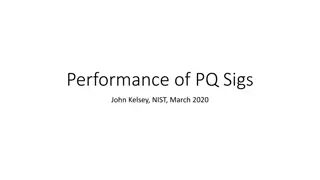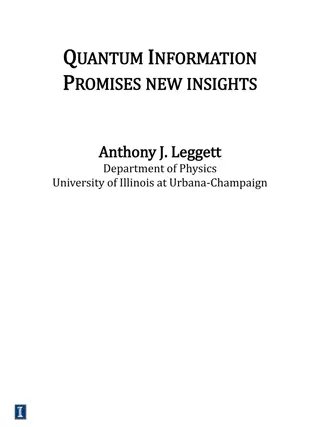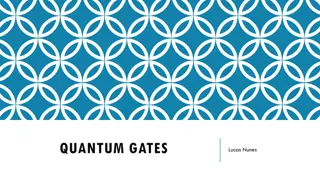Quantum Query Complexity Measures for Symmetric Functions
Explore the relationships between query complexity measures, including quantum query complexity, adversary bounds, and spectral sensitivity, in the context of symmetric functions. Analysis includes sensitivity graphs, the quantum query model, and approximate counting methods. Results cover spectral sensitivity of threshold functions, adversary bounds for symmetric functions, and the quantum complexity of Gap Majority.
Download Presentation

Please find below an Image/Link to download the presentation.
The content on the website is provided AS IS for your information and personal use only. It may not be sold, licensed, or shared on other websites without obtaining consent from the author.If you encounter any issues during the download, it is possible that the publisher has removed the file from their server.
You are allowed to download the files provided on this website for personal or commercial use, subject to the condition that they are used lawfully. All files are the property of their respective owners.
The content on the website is provided AS IS for your information and personal use only. It may not be sold, licensed, or shared on other websites without obtaining consent from the author.
E N D
Presentation Transcript
On query complexity measures and their relations for symmetric functions Sanjay S Nair, IIT Kanpur Rajat Mittal, IIT Kanpur Sunayana Patro, IIIT Hyderabad 10th Annual International Conference on Algorithms and Discrete Applied Mathematics, IIT Bhilai
Motivation Query model can best describe many quantum algorithms and it offers concrete lower bounding techniques. Ronald de Wolf formulated the quantum query complexity for total symmetric functions. Spectral sensitivity was found to serve as a lower bound for adversary method and quantum complexity. We are looking into the adversary bounds of symmetric functions, and the quantum complexity of some partial symmetric functions
Preliminaries Sensitivity graphs Quantum Query model Adversary Method Spectral sensitivity Approximate Counting
Sensitivity graphs For a boolean function ?: 0,1? 0,1 , input is sensitive at an index if flipping the value at the index will change the output. The sensitivity graph has vertices as all inputs, and edges denote sensitive inputs. Also represented by adjacency matrix ??. O1 ??2 11 OO 1O
Quantum Query model Output obtained by series of queries through unitary oracle. |0 ??. |0 ??= ?????? 1?? ???0
Adversary Method Given by Ambainis as a lower bound for quantum query complexity, evaluating query model using a relation R X ?. Many variations were introduced; All were found identical. ?? ?? ??? =
Spectral Sensitivity Spectral norm of Adjacency matrix of a boolean function. It was found to be a lower bound for the adversary method by Aaronson et al. ? ? = ?? = max ?: ? =1??.?
Approximate Counting Approximate estimation of the hamming weight of the input. With an allowed error rate of ? for input ?. 1 ? ? ? ??= ?
Results Spectral sensitivity of threshold functions. Adversary bound of total symmetric functions. Quantum complexity of Gap Majority. Noisy randomised query complexity vs quantum query complexity.
Threshold functions ?? is a binary vector with the value of 1 only for indices with hamming weight k. 0 k n 0 1 ???.?? ?? = ? ? + 1 ? ?.? ;? ? ? ?? = 2
Total symmetric functions The adjacency matrix of a total symmetric function can be expressed as the sum of the matrices of the constituent threshold functions. constant 0 n ?? ? ?? ??= ??? ?:? ? ?(? 1) ?? ???? ???+? = ?.??
Adversary bound and Certificate Game Complexity A min-max formulation of adversary shows that it is very similar to the square root of certificate game complexity for symmetric functions. The weight function gives the same optimal results for both formulations. ??? ? = min ? ??? ? max ? ?,? ?? ? = min max ????? ? ? ?,? ? ? ? ? ?.? ? ?,? 0 ?.? ? ?,? 0 ?? ? ?(?) ? ?,? .? ?,? 1 ?? ? ?(?) ? ?,? .? ?,? 1 ?:?? ?? ?:?? ?? ?? ? = ???+? = ?.??
Gap Majority: Quantum algorithm We look into a new quantum algorithm by approximate counting To count without overlap, the allowed error rate can be 1 ?. ? 2 ? ? 2+ ? 0 n ????????? = ? ?
Gap Majority: Lower bound on complexity The lower bound can be provided by the adversary method. R is (x,y) such that all bits set in x are also set in y. ? 2 ? ? 2+ ? 0 n ?.? ?.? ??? = ????????? = ?
Corollary: Noisy randomised query complexity We have two known relations for noisy randomised complexity and query complexity related to gap majority for all total boolean functions. ??(? ???????) = ? ???????? ? ??? .??(???????) = ??(? ???????) ??(?) = ? ???????? ?
Relations of complexity measures (?2) ?1?0= ??2 ?.?? (?3/2) (?) ?? = ???+2 ? = ?? = ?? = ? = ?????? ?? ? ?.?? ? = ???+= ? = ???
Future work Quantum complexity of Gap threshold functions Adversary bounds for transitive functions.
Literature Aaronson, S., Ben-David, S., Kothari, R., Rao, S., Tal, A.: Degree vs. approximate degree and quantum implications of huang s sensitivity theorem. In: STOC 21 de Wolf, R.: A note on quantum algorithms and the minimal degree of - error polynomials for symmetric functions. Quantum Inf. Comput. (2008) Brassard, G., H yer, P., Mosca, M., Tapp, A.: Quantum amplitude amplification and estimation. Quantum Computation and Information p. 53 74 (2002) Ambainis, A.: Quantum lower bounds by quantum arguments. In: Proceedings of the 32nd Symposium on Theory of Computing, 2000 Chakraborty, S., G l, A., Laplante, S., Mittal, R., Sunny, A.: Certificate Games. In: Tauman Kalai, Y. ,14th Innovations in Theoretical Computer Science Conference (ITCS 2023)























